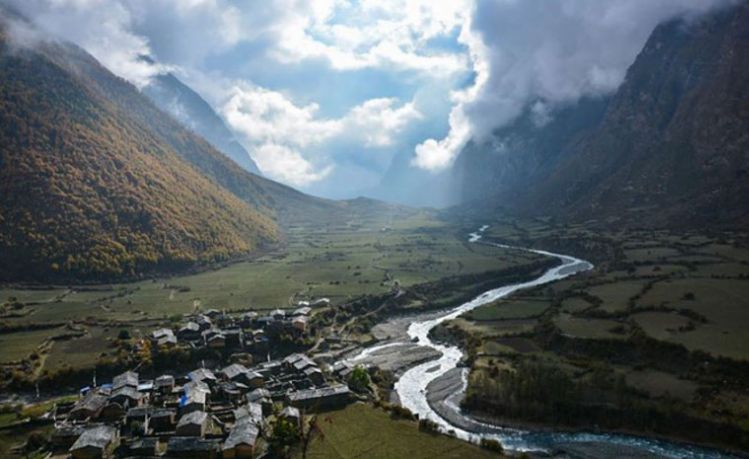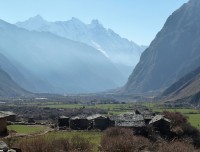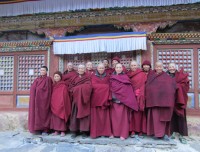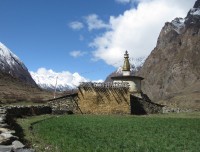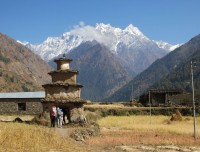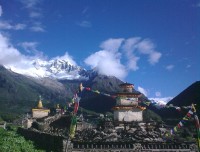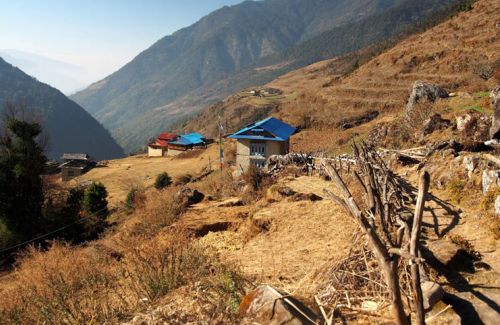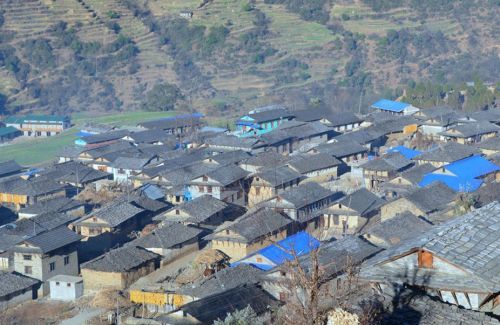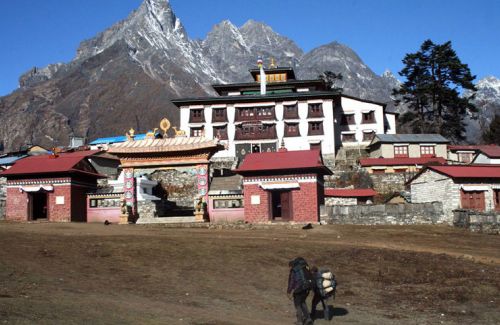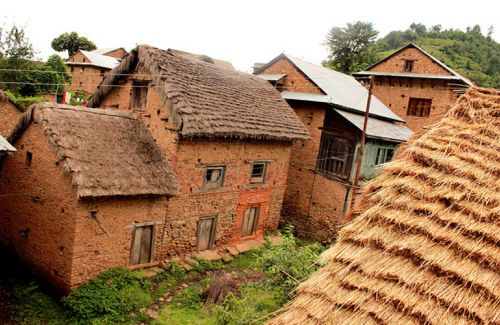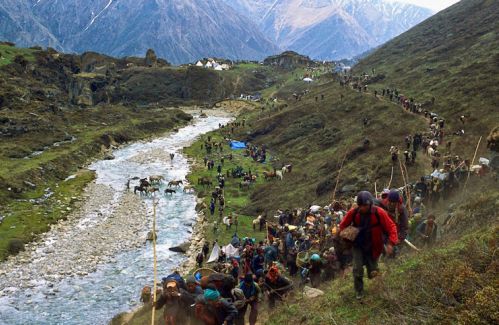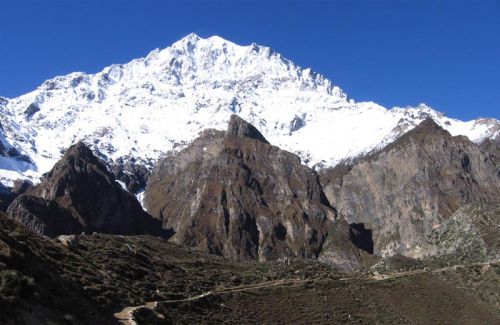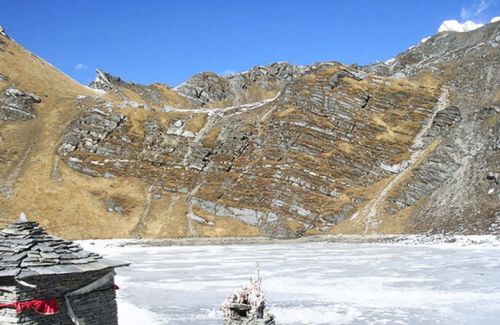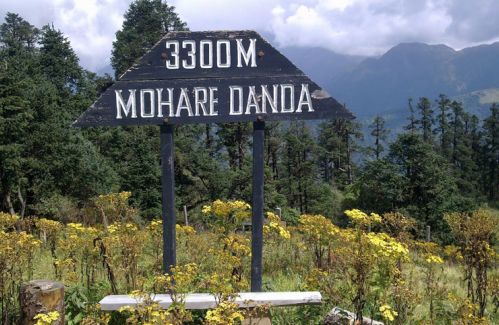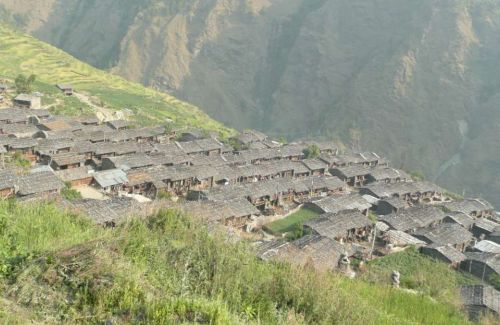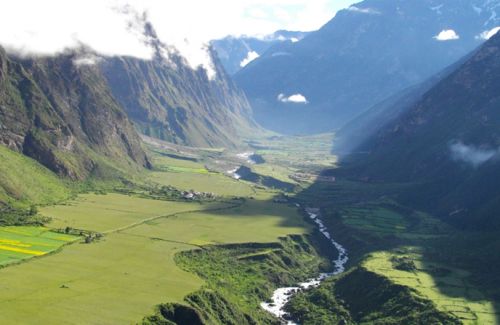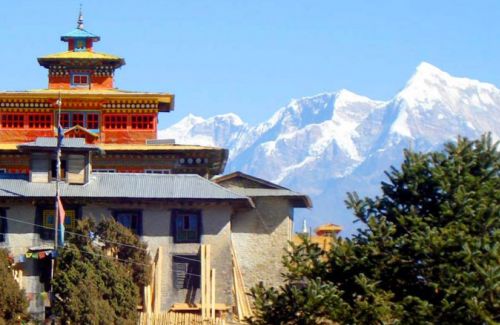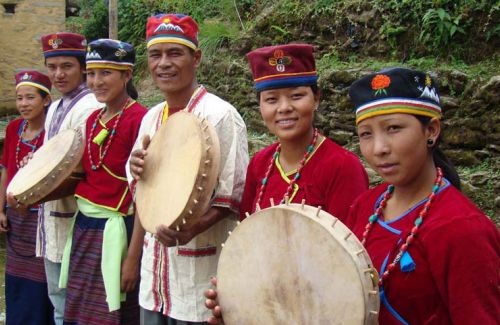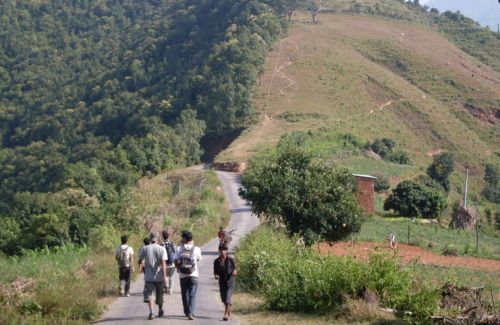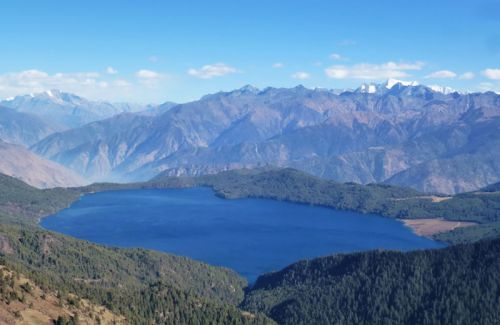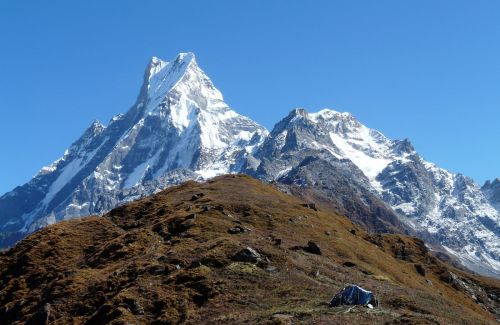Happy Tsum Valley Trek
- Duration19 Days
- Max. Altitude4,180 m
- Starts FromUSD 1625
Destination:Nepal
Trip Grade:Moderate (**)
Meals:Breakfast + Lunch + Dinner
Transportation:Public Vehicle
Accommodation:Lodge
Trekking Region:Manaslu Region
Show All
Tsum Valley is the newly explored trekking trail situated in the northern Gorkha, Nepal. It lies in the restricted trekking zone of Manaslu region. Tsum Valley is known as the sacred valley culturally and naturally scenic with magnificent Himalayan beauty. The word Tsum came from Tsombo which means ‘Vivid’. Tsum valley used to be called Tsum Tso Chucksums means thirteen provinces ruled by the single territory. This geographically wonderful place and culturally unique and rich Tsum valley is on the backdrop of Ganesh Himal, Sringi Himal and Bouddha Himal ranges.
There are number of old Buddhist monasteries, chhortens, Mani walls and Kaanis. The longest Mani walls over 250 m long are at Dzong and Phurpe. The Tsum Valley has preserved the old norms and values, traditions and the steps shown by Buddhist Yogi Chyuchin Milarepa and Guru Padmashambhava’s circumambulation. People here in Tsum Valley neither slaughter the animals nor sacrifice in the name of Gods.
Tsum Valley has unsurpassed beauty and mingling of Tibetan and Nepalese culture which offer a true adventure for visitors to Tsum Valley. We can experience the mountains and valleys with diverse and pristine eco-systems. Tea house or Home Stay has been built. Tea house trek is comparatively least cost so that it is affordable most of you. If you do tea house trekking, there is simple accommodation and foods are Nepalese dishes.
Initially the journey starts from Kathmandu. We will drive from Kathmandu to Aarughat, Gorkha. Most of the trail goes through the bank of Budhi Gandaki River. Walking beside Budi Gandaki River, the path then takes us through beautiful forest, terraced fields and hilly villages. Going further to Tsum valley, the sketch of village starts to change. Furthermore, the trail goes through alpine forests, glacial rivers. Passing Liding, Machhakhola, Jagat and Philim and some other beautiful villages, we will reach Tsum valley where we can enjoy its beauty. Then after we will follow the same path and return back to Kathmandu. Himkala Adventure offers the best services with our professional and trained guides. You could customize your trip as per your requirement.
Trip Highlights
- Sightseeing at World Heritage Sites in Kathmandu
- Scenic drive from Kathmandu - Aarughat - Kathmandu
- Visit hilly region with rolling terraced farmlands
- Following the famous Trishuli, and Budhigandaki Rivers
- Visit the valley of happiness
- Feel the newness in the way of living of Tsum Valley Trek
- Untouched land, unique culture and ritual practices
- Mani Walls, chortens and kaanis
- Splendid mountain view of Manaslu and Ganesh Himal
- Natural trekking trail - off the beaten path
- Rejuvenate with hot spring shower
Day to Day Itinerary
Day 01:Arrival in Kathmandu (1,350 m) and Transfer to Hotel. Overnight at Hotel
Day 02:Pre-Trip Meeting and sightseeing at World Heritage Sites in Kathmandu. O/N at Hotel
Day 03:Drive from Kathmandu to Aarughat (608 m), 6 hrs. O/N at Guest House
Day 04:Trek from Aarughat to Sotikhola (700 m), 6 hrs. O/N at Guesthouse
Day 05:Trek from Sotikhola to Machhakhola (869 m), 6 hrs. O/N at Guesthouse
Day 06:Trek from Machhakhola to Dovan (1070 m),5 hrs. O/N at Guest House
Day 07:Trek from Dovan to Philim (1570 m), 5 hrs. O/N at Guest House
Day 08:Trek from Philim to Chumlimg (2386 m), 6 hrs. O/N at Guest House
Day 09:Trek from Chumling to Chhokang Paro (3031 m), 5 hrs. O/N at Guest House
Day 10:Trek from Chhokang Paro to Nile (3361 m), 6 hrs. O/N at Home Stay
Day 11:Trek from Nile to Mu-Gompa (3700 m), 4 hrs. O/N at Gompa
Day 12:Exploration at Mu-Gompa. Overnight at Gompa
Day 13:Trek from Mu- Gompa to Ranchen Gompa (3240 m), 6 hrs. O/N at Home Stay
Day 14:Trek from Ranchen Gompa to Philim (1570 m), 7 hrs. O/N at Guesthouse
Day 15:Trek from Philim Tatopani (990 m), 6 hrs. ON at Guesthouse
Day 16:Trek from Tatopani to Soti Khola (700 m), 7 hrs. O/N at Guesthouse
Day 17:Trek from Soti Khola to Aarughat Bazaar (608 m), 5 hrs. O/N at Guesthouse
Day 18:Drive from Aarughat Bazaar to Kathmandu, 6 hrs. O/N at hotel
Day 19:Departure to International Airport
Cost Include
- Airport picks up and drops off by private tourist vehicle
- A government licensed holder city tour guide
- Three nights in Kathmandu in twin sharing 2-3 star hotel with Breakfast
- Guided city tour in Kathmandu by private tourist vehicle
- Drive from Kathmandu - Aarughat - Kathmandu
- Full board meals (Breakfast + Lunch + Dinner) during the trek
- Lodges, Guesthouses accommodation during the trek
- Professional license holder English speaking Trekking Guide
- The required number of local staff and porters (2 Trekkers = 1 Porter)
- Food, accommodation, salary, insurance, equipment and medicine for all staff
- Manaslu Conservation Area Entry Permit, TIMS, and Special Permit for Tsum Valley trekking
- Down Jacket, Duffle bag and sleeping bag by Himkala Adventure if required
- Farewell Dinner in typical Nepalese restaurant with cultural show
-
Government taxes, VAT and Service charge
Cost Exclude
- Lunch and dinner in Kathmandu
- Entrance fee in all monuments during tour
- Emergency rescue and evacuation cost
- Your travel insurance
- Nepal entry visa fee
- Personal expenses like: phone bill, laundry, hot shower, hot and cold drinks etc
- Personal trekking equipment
- Tips for trekking, tour staff and driver (Tipping is expected)
-
Any others expenses which are not mentioned on ‘Cost Includes' section
Detail Itinerary
Day 01Arrival in Kathmandu (1,350 m) and Transfer to Hotel. Overnight at HotelThe representative from Himkala Adventure will be in the airport to welcome you. When you come out after completing custom formalities, you will see our representative holding Himkala’s placard or your name, standing in front of the terminal building. They will greet you and transfer to hotel. Overnight at Hotel
Day 02Pre-Trip Meeting and sightseeing at World Heritage Sites in Kathmandu. O/N at Hotel We brief you about our program commence from today. After breakfast, we visit some UNESCO World Heritage Sites where one can see the medieval arts, architecture, crafts and get to be familiar with our history. The traditional norms and values through the ritual activities shown by typical Newar people of Kathmandu can succinctly be seen. The monks chanting “OM MANI PADME HUM” and walking around the stupa spinning prayer wheel in yellow or maroon dress develops the tranquility in mind. We visit monkey temple, Kathmandu Durbar Square, Boudhanath, Pashupatinath Temple. After all this experience, we come back to hotel.
Day 03Drive from Kathmandu to Aarughat (608 m), 6 hrs. O/N at Guest House After breakfast, we drive from Kathmandu to Aarughat along the Prithivi Highway then we branch off to from Malekhu towards Aarughat Bazaar. It takes 6-7 hours by public bus.This is a scenic drive through hilly region following the Trishuli River, crossing many bridges. The rural landscape with terraced farmlands is panoramic. Overnight at Guest house
Day 04Trek from Aarughat to Sotikhola (700 m), 6 hrs. O/N at Guesthouse We trek over a flat leveled path along the bank of Budhi Gandaki River through mostly terraces, numerous villages, green hills, some pretty waterfalls and lush green forest. We can see beautiful local houses with dark slate roofs on the way. The trail will take us through an old market place of Arkhet which has stone paved roads. We will have overnight stay at Soti Khola.
Day 05Trek from Sotikhola to Machhakhola (869 m), 6 hrs. O/N at Guesthouse The trail resembles the roller coaster ride as we follow Budi Gandaki River. We will also get to observe numerous waterfalls on the way. The trail gets narrow and rocky at places. We cross various thrilling suspension bridges at intervals. As we traverse slowly Lapubeshi village appears with sparse houses. The village is mostly inhabited by Mongolian people. We descend to the riverbed and follow the stony path until we approach Machha Khola.
Day 06Trek from Machhakhola to Dovan (1070 m),5 hrs. O/N at Guest House After breakfast, we descend down the stream and walk beside the river. After crossing the Machhakhola, we head upstream to the tiny village of Khorlabenshi and the hot spring of Tatopani. From here we have to follow the ridge of the Budhi Gandaki River until we reach to Doban.
Day 07Trek from Dovan to Philim (1570 m), 5 hrs. O/N at Guest House We cross the suspension bridge over Budhi Gandaki River. The trail is rocky. We slowly approach stone staircase reaching Jagat, a picturesque village with packed stone houses. The trail meander across the river - up the ridges - through Salleri village past stone water mills followed by millet and corn fields to arrive at a beautiful Gurung Village of Philim.
Day 08Trek from Philim to Chumlimg (2386 m), 6 hrs. O/N at Guest House Today, we gain more altitude. The trail resembles a roller coaster ride going uphill and downhill through a dense forest. We cross rickety suspension bridges over gushing streams to reach Chumling. Chumling is located on the south face of Shringi Himal. The day is a bit challenging as we have to ascend almost the whole day. We stay overnight at Chumling
Day 09Trek from Chumling to Chhokang Paro (3031 m), 5 hrs. O/N at Guest House The view from Chumling is an incredible. The trek is strenuous today but the scenic view of the valley amply compensates for the long walk. We slowly approach to Chhokang Paro. Chhokang Paro is situated on a flat land and consists of two settlements. The area has prominent Tibetan Buddhist heritage.The area is marked by beautiful chortens and mani walls. We will be staying at Chhokangparo tonight.
Day 10Trek from Chhokang Paro to Nile (3361 m), 6 hrs. O/N at Home Stay Nile is the last permanent settlement of Upper Tsum Valley, located at the bank of Shiar Khola. The area is marked with chortens, kaanis and mani walls. On the way to Nile, we trek towards the sacred Buddhist pilgrimage site in the area - Milarepa Piren Phu or Milarepa cave located in Burji village. The great sage of Tibetan Buddhism Philosopher Milarepa is said to have meditated. There are two gumbas attached to the cave which contains the statues of Milarepa, Buddha, Avaloketishvara and Tara.
Day 11Trek from Nile to Mu-Gompa (3700 m), 4 hrs. O/N at Gompa Dephyudonma Gompa (4,060 m) is the oldest Gompa located in this region. It takes approximately two hours to reach. We have to walk further up to visit Mu Gompa (3,700 m). There are no settlements in this area as it is located at the end point of Tsum Valley. This gompa falls in the ancient trade route between Nepal and Tibet. En route, we can see flocks of Himalayan Thar and Blue Sheep. We have to descend back to Mu Gompa as it has good camping sites.
Day 12Exploration at Mu-Gompa. Overnight at Gompa Today is our rest day. We slowly explore the valley. We take a trip to Mt. Pika (4865 m) from where we can have spectacular view of natural border with Tibet in the North and Ganesh Himal in the South. We can explore the old caravan trail to Tibet. Then we head back to Mu Gompa
Day 13Trek from Mu- Gompa to Ranchen Gompa (3240 m), 6 hrs. O/N at Home Stay After breakfast, we trek to Rachen Gumpa which is also one of the largest monasteries in the valley. It has beautiful statues of Buddha Amitabha, Padmasambhava, Avalokiteshwara and Tara. Beautiful paintings of Buddhism are painted in the interiors of the monastery. The monastery is influenced by the Nyigmapa sect of Tibetan Buddhism. Followers of Nyigmapa do not offer animal sacrifice neither do they slaughter animals.
In upper Tsum Valley one child from every family is sent to be monk or nun in the local monastery. We also visit another famous monastery of this area – Gonhgye Gompa which means thousand Buddhas monastery. We trek back to Rachen Gompa for the overnight stay.
Day 14Trek from Ranchen Gompa to Philim (1570 m), 7 hrs. O/N at Guesthouse From today onwards we will be descending. We begin by dropping down to Dumje - small picturesque village with handful of stone houses. As we descend we can notice the change in landscape and vegetation. After a delightful breakfast, we descend down to Philim. En route, we encounter the most spectacular waterfall. As we pass through the sparse village of Ripchet, the trail leads through corn and millet fields. After the long trek, we arrive at Philim. Philim is one of the large villages in the area which has majority of people belonging to Gurung ethnicity.
Day 15Trek from Philim Tatopani (990 m), 6 hrs. ON at GuesthouseToday we descend from Philim to Tatopani. We cross the suspension bridge and view beautiful landscape. In a while, we get to observe exotic stone water mills on the way to Tatopani. Tatopani has a natural hot water spring, after the long and arduous trek, we can relax and revitalize in the hot water here.
Day 16Trek from Tatopani to Soti Khola (700 m), 7 hrs. O/N at GuesthouseAfter breakfast, we retrace back to Soti Khola. We can feel the place warmer than before as we descending to low land.
Day 17Trek from Soti Khola to Aarughat Bazaar (608 m), 5 hrs. O/N at GuesthouseToday we descend the same way that we took in the beginning of the trek. We retrace step down hill and reach to Aarughat Bazaar.
Day 18Drive from Aarughat Bazaar to Kathmandu, 6 hrs. O/N at hotel After a delicious breakfast, we drive from Aarughat Bazaar to Kathmandu. The bumpy ride along the meandering highway will take most part of our day. After we reach Kathmandu, we take a hot water shower and relax; farewell dinner will be waiting to celebrate your successful journey to Tsum valley. Overnight at hotel in Kathmandu
Day 19Departure to International Airport We transfer you to the airport 3 hours before your flight. So, as per your flight schedule, we check out from the hotel and leave you at International terminal side at airport with showing gratitude joining with Himkala Adventure for the trek to Tsum Valley. Namaste with Palms together!!!
Trip FAQ
Himkala Adventure would like to answer all the queries about Happy Tsum Valley Trek for all curious travelers/trekkers in the world. As you are entirely from different geographical location, you could better to know everything about the treks from the beginning i.e. airport pick up till your departure like airport picks up, drops off, accommodation in city, in the trek, guide and porters, safety for the trekking, food and accommodation and some other things that you might face on the way. Hope our endeavor listing these questions answers will help you self informed.
This is simply the outlines of the services we offer but it may differ as per your requirement, number of trekkers. What we go through our conversation, we will manage the means of transportation, hotels in the city, accommodation in the trekking, numbers of porters etc. This is general idea about Happy Tsum Valley Trek before your trip and you become clearer about the trek. Please feel free to contact us to get more information about the trekking in the Himalayas of Nepal.
1) How is Happy Tsum Valley Trek in Nepal?
Tsum Valley is one of worlds remotest Himalayan Valleys which was also a restricted region until recently. The trek to Tsum Valley takes you into the majestic surroundings of the Ganesh Himal, Sringi Himal, and Boudha Himal ranges. The region once being part of Tibet looks completely different from what you will find elsewhere. The people of Tsum Valley or the Tsumbas belong to Tibetan origin with their own ancient form of dialect, art, culture and religion.
2) What physical fitness do I need to book this trip?
Every trekking in the Himalayas of Nepal requires the certain level of physical and mental fitness. So, we advise you to be in good physical shape and able to feel comfortable while hiking up and down 7 to 12 miles per day on a trail carrying a day pack of about 10 pounds. Three things could make you confident enough for any trek you would like to do: aerobic, strength and mental.
Aerobic conditioning is important primarily because you will be trekking in thinner air, up to 40% less than at sea level. With good aerobic conditioning, you will be able to better metabolize whatever oxygen is available to you. You should plan on doing at least one hour of aerobic 3 /4 times per week for 1 month or more before your arrival in Nepal. Walking, jogging, cycling, hiking on floor to ridge line ascents with day back are some of the excellent forms of exercise, so long as you are strengthening leg muscles and building stamina. Speed is not the essence; stamina, confidence and continuity are. Do as much uphill as possible. If you live in flat area, go to the stadium and use the steps with your pack.
3) Do I really need to use guide to Happy Tsum Valley Trek?
You are advised to use Guide so that you could feel safer in the unknown area because the guide can tell you the possible danger as they have guided in this region since long. Most importantly, the Himalayan weather is really unpredictable and the Guide can help you to take proper shelter. Nest advantage to be with Guide is you get more knowledge about local culture and you could have easy access to interact with the local people. In 2014, the Nepal Government clearly has stated that the trekkers should have a guide but still it is not seemed in the practicality.
4) How do I find Himkala Adventure for my pick up at the airport?
Our representative from Himkala Adventure will display a small board (placard) of company or your name outside the airport terminal. You will be driven to the hotel by our tourist vehicle.
5) What sort of accommodation do I get in Kathmandu?
Normally we provide standard rooms with twin sharing accommodations at three star or similar category hotels in Kathmandu including breakfast. Accommodation in these cities can be upgraded as per your request. But some of our packages are sold without accommodation in the city.
6) How are tea house facilities during Happy Tsum Valley Trek?
Tea House is the combination of guest house, restaurant, and social hang out. Tea houses in Happy Tsum Valley Trek area are professional though they are simple but with neat and clean lodging offering fine views and plain but fresh and hygienic food with friendly atmosphere Most of the Tea Houses have running water facility. Many of them have hot water available for bathing. But we discourage our groups from using water heated by wood as lack of firewood in most villages is a big environmental concern in Nepal.
7) What sort of accommodation do I get in trekking?
Guesthouses/Tea Houses/Lodges provide twin sharing single and double rooms and occasionally a dormitory which is basically clean with a mattress and a quilt or blanket. Our company provides the sleeping bag if needed but we always recommend having your own sleeping equipments. You have to share the room with your group member or sometimes with unknown traveler. The toilet is always outside the room with basic facilities.
8) What sort of foods, water and drinks can I expect in trekking?
The foods in the Himalayas are very simple. There are mostly the family members themselves to cook and serve the meal. They are simply trained but experienced because they have been offering such services for many years in this busy route. The food is hygienic, fresh and delicious. We recommend you to drink mineral water or the boiled or using water purification pills or drops.
Most of the foods are cooked in the kitchen of tea houses. They serve you with different varieties of delicious Nepali and continental dishes. The most popular Nepali food is daal bhat (rice and lentils) with some mixed vegetable curry. Garlic soup is popular as it helps you with acclimatization. You could better be vegetarian in the mountains. All hotels in cities and guesthouses in trekking serve the vegetarian food. You can find all common types of drinks like hot chocolates, coffee, tea, hot lemon with honey, ginger tea, soft drinks etc. you will have your breakfast and dinner at the lodges where you will be staying and lunch somewhere on the way to your next destination.
9) What mode of transportation do I use?
We will provide the private transportation for Airport/Hotel/Airport pick up and drop and sightseeing in Kathmandu Valley. We use transportation as based on our cost inclusion section. The transportation varies depending on your requirements at the time of booking the trip.
10) What is the best season for this trekking?
The best season for Happy Tsum Valley Trek is spring (March to May) and autumn (September to December). These are the perfect time of the year for the breathtaking views of Himalayas with clear and sunny days. But the weather in the mountains is unpredictable.
11) What is the weather and temperature like during the trekking?
The climate in Nepal varies from place to place which can be categorized in different four main seasons. The main seasons in Nepal are spring (March to May), summer (June to August), autumn (September to November) & winter (December to February). The best season to travel in Nepal is autumn (September, October & November) & spring (March, April & May). Weather in the mountains is unpredictable. But the day temperature in Happy Tsum Valley Trek is comfortable.
12) Who will be guiding me during this trip?
We provide the professional government license holder English speaking trekking guides for our entire trekking trip. We can also provide French, Spanish, Japanese, German or Italian speaking guides as per your preference with extra payment but not guaranteed. All guides will be Nepali people who are carefully selected on the basis of their appropriate experience, leadership skills and personality. They are all trained from Nepal Academy of Tourism and Hotel Management, certified and approved by the Tourism Department of Nepal government. We provide a different city tour guide to guide you in UNESCO World Heritage Sites in Kathmandu. They are the professional license holder guide specialized in culture, history, geography, iconography, archeology and religion with good command over English. Tour guides are specialized in city tour and trekking guides are more in the hiking and trekking in the Himalayas.
13) What sort of experience do your guides have?
Our entire city tour guides have bachelors to Master Degree academic education along with many months tour guiding training from Nepal Academy of Tourism and Hotel Management, Rabi Bhawan, Kathmandu, Nepal. They are fluent in spoken languages and informative about the sites in many aspects. They are quite experienced and dedicated to their job and responsibilities.
Our entire trekking guides have minimum Intermediate to Master Degree academic education with trekking guide training from Nepal Academy of Tourism and Hotel Management, Rabi Bhawan, Kathmandu, Nepal. Many of them are from villages. As they are local, they know more about the routes, necessary precaution to be taken and so on. They have spent many years exploring many parts of the country. They are trained in first aid and able to handle any situation easily. They speak good English and make you know about the places you visit.
14) May I charge my electronic gadgets during Happy Tsum Valley Trek?
Most of the places in your tea houses have charging facilities. You can charge your devices by paying some extra money. It’s good if you bring TWO or THREE pin travel adapter and put your gadgets at warm place at night.
15) How much additional money is required for this trip?
It’s a very personal question as expenses depend on habit. Normally, in Kathmandu you can allocate about USD 10 to 15 per person per lunch or dinner. USD 10 to USD 15 per person per day will be sufficient to buy bottles of water, chocolates, pay for a hot shower during the trekking. Other personal expenses will be your own calculation.
16) What is the social and environmental responsibility of Himkala Adventure for this trip?
The situation of environment in Nepal is in considerable stage due to so many factors caused by global warming, human activities, and adverse effects of natural incidents. Nepal is in between two giant countries like China and Nepal. The ozone layer is depleting and the atmosphere is getting heated. So, its direct effect is to the Himalayas that the snow is melting day by day and the sea level is rising. It is due to population growth, people are clearing the forest and the soil is being eroded. As a part of society, and our trekking related activities are directly concerned with the social and environmental things. We are very conscious not litter in the open spaces, to manage garbage properly and make local people aware in this campaign. We are working together with other companies and taking these issues seriously.
17) What is the minimum number requirement for this trip?
We operate individual trip to the group joining trips for Happy Tsum Valley Trek. If you want to do any private trip we are ready to organize for solo traveler as well with some additional charges.
18) Are there communication or internet services during Happy Tsum Valley Trek?
All our guides carry the local mobile phone. You can use his mobile phone to make any local or international call from trekking trails by paying him directly. You can even pass him number to be connected with your family or friends. We highly recommend taking local SIM card for call and internet services during trekking. Local SIM cards are easily available in many stores and at airport as well. You need to provide two copies of your photographs and your passport copy to get local SIM CARDS of NCELL & NTC (only these two companies provide telephone services in Nepal.
19) May I get chances for shower during Happy Tsum Valley Trek?
Most of the guesthouse provides hot shower with some extra cost. In few places, bucket water will be provided for the shower.
20) May I add extra days in trekking?
Yes. You can customize the trek as you would want. We are flexible while preparing the itinerary and you could lengthen or shorten it as per your requirement.
21) What happens in case of emergency?
Himkala Adventure has prepared for any emergency situation and knows how to handle it. Our guides are trained in first aid and can deal with most of the basic ailments that occur during the trek. Every client should have his own insurance before coming to Nepal for the case of emergency.
22) Do I need to have insurance for this trip?
We request you to have a travel-insurance policy to cover theft, loss, medical problem & emergency helicopter evacuation from high altitude places before coming Nepal. Choose a policy to cover your emergency high altitude helicopter evacuation with all medical insurances for trekking in high altitude in the Himalayas of Nepal. Your travel insurance is always needed before going in any high altitude trekking. Please check your travel insurance policy which doesn’t exclude mountaineering or alpinism. Although you will not be engaging in these activities in your trekking, you might have problem convincing the insurance company of this fact. Rescue insurance need to cover an emergency helicopter evacuation or a charted flight from remote mountain trails of Nepal as well as international medical evacuation. A helicopter evacuation might cost US$ 2500 to US$10000 depending on the places. So that travel insurance to cover all above is must to travel in the high Himalayas of Nepal.
23) What type of shoes should I wear during Happy Tsum Valley Trek?
You could better have carefully chosen hiking boots with extra laces which should be kind of strong, well-made but light boots for Happy Tsum Valley Trek. Shoes and boots are best to buy before arriving in Nepal. We advise you to wear your new shoes for sometime before trek so that you could feel well habituated on the newer trail for your feet.
24) Can I use credit cards in the Happy Tsum Valley Trek route?
No, you can use only in the cities like Kathmandu. So, it is better you to make change in Kathmandu. When you are out of city, all you need is cash, better to have small notes. Please change the currency in local Nepali rupees before you go to the mountains.
25) Do I need to tip my guide and porter? How much would that be?
Tipping is not mandatory, neither it is right to ask by anyone but it is a way of showing gratitude after taking service. The level of tip also shows how satisfy you are from the team that you had been during your tour/trek.
However, we recommend you to spend minimum 10% of your total trip cost for tipping entire local staffs, the ratio of tipping guide and porter will be given to you at the pre-trip meeting in Kathmandu before starting the trek.
26) How is Camping Trek to Tsum Valley being operated?
Camping trek is fully organized and supported, with a team of guides, cooks, and porters to accompany you. Our porters carry all the trekking gear, food, fuel and personal belongings. Our cooks prepare hot meals. Trekkers need only carry a small bag as required for the day. At night, tents for dining, sleeping and ablutions tents are provided and set up, also mattresses and down-filled sleeping bags, tables and seating.
In a typical camping trek, we start the day around 6 a.m. with a cup of hot tea. You are then provided with a bowl of warm water for washing. Then trekkers enjoy breakfast before leaving camp. The trek begins around 7.30 - 8 a.m.
Trekkers can set their pace for pausing and sightseeing and the walk to the lunch spot will normally take 3 hours. On arrival, you are served hot lunch. In the afternoon, after walking for another 3 to 4 hours, you arrive at the next camp around 5 p.m. Tea & snacks are served while our staff readies the camp. Dinner time is around 6/7 p.m. in the dining tent, lit with lanterns and comfortably furnished. The food is healthy, wholesome and hygienically prepared.
Trip Note
Cost:
The cost of trip varies according to the number of travelers in the group, the category of the Hotel, mode of the transportation and any kind of changes (if there is). So, if you would let us know all of these above mentioned things, then we could quote you the exact price.
Essential Documents:
You are requested to send the following documents after you confirm or book the trip with Himkala Adventure:
A copy of your passport and travel/health insurance documents with contact details, three passport size photos.
It is advised to maintain a separate photocopy of all important documents including traveler’s cheques, bank/ATM card, contact numbers, international flight tickets, and emergency contact numbers.
Weather:
The main trekking season in Nepal is from October to December and March to May. The day temperature for walking to Tsum Valley is comfortable. The sky is clear although there is snow and rainfall occasionally. It is about 10 degree centigrade at the height of 3,600 m and increasingly lower, the higher we go.
Nepal Strikes:
There is much more progress in the political scenario in Nepal and we assure you that travelling in Nepal is safe. But there may be Bandha (wide transport strikes) at a very short notice. The shuttle bus is in operation by Nepal Tourism Board and the Nepal Tourist Police in conjunction with the Himalayan Rescue Association from domestic and international terminal to the various hotels in Kathmandu. The service costs 300 rupees per person.
Itinerary Disclaimer:
Himkala has thoughtfully designed all the itineraries but our itineraries are updated for the betterment on the basis of our past travelers’ comments and our own research. In case you find changes in the itinerary you printed and the upgraded one does not affect your trip. Please note that some changes may occur in our itineraries due to bad weather and common seasonal changes to timetables and transport routes.
Physical Rating:
Your trip will be meaningful if you could find yourself fit and fine. You will be walking up to 4,180 m from the sea level. As the geographical region varies, there is a temperature variation as well. So, we advise you to undertake regular physical exercise, jogging, hiking, riding, ascending and descending the long stairs etc. Precautions and acclimatization are undertaken but be aware of the effects altitudes can have.
Group Size:
Himkala Adventure organizes solo to group travelers. Our group trips are designed for sharing accommodation and there is no single supplement. Single travelers share with the same gender from twin to multi-share in an accommodation. You are requested to have mutual understanding in between the fellow travelers who have joined from the different parts of the world. Please remember that you have great responsibilities in the group. If you are requested to be at a particular place at a certain time, make sure that you have been there at a time. It is much more pleasing sharing experiences and traveling together.
Accommodation and Meals:
Accommodation and Foods in the Himalayan region of Nepal cannot be compared with any developed countries in the world. We know that you might not have experienced such things before but you should take it easy. Accommodations at local lodges are simple but clean and comfortable. The food is plain. Toilets and washing facilities are shared and rudimentary. In high altitude regions, there are very few tea houses and one has to be happy to share in simple dormitories without electricity, without running water. Hot shower means a bucket of hot water upon our request.
Money Matters:
Please note that most establishments in Asia will not accept foreign currency notes that are old, torn or faded and they can be very difficult to exchange or extra fees added when exchanging at banks. Please ensure that you have new, clean notes.
The official currency of Nepal is the Nepali Rupee (NPR). ATMs can be found only in major cities of Nepal like Kathmandu, Pokhara, Chitwan, Bhaktapur etc. The government of Nepal has banned the import, export and use of 500 and 1000 Indian rupee notes in Nepal. You make sure that you won’t carry these notes upon arrival in Nepal, otherwise they are confiscated and you may be fined.
Please make sure that the foreign currency notes that you have are new and clean notes because old, torn or faded foreign currency notes in Nepal are very difficult to exchange or extra fees added when exchanging at banks.
While travelers cheques have security advantages exchanging them can be a lengthy process, commissions can be high (up to 10%) and they can be difficult to change in rural areas, on weekends and public holidays. If you choose to bring travelers’ cheques, make sure they are a major brand and major currency.
Tipping:
Tipping is not mandatory. It is not anyone’s right asking for tips but if you are happy with the service, you could tip the staffs. It is entirely a personal preference. Tipping could be significant to them who took take great care of you in your traveling period. Himkala recommends that you could tip any intended recipient by any member of the group than collected and passed on by the group leader.
Note: Please do not tip with coins or dirty and ripped notes. This is culturally taken as an insult.
Local Dress in Nepal:
Nudity is a sensitive issue in Nepal. Women should avoid wearing shorts and sleeveless tops in public places where this might be seen as inappropriate. Remove shoes before entering certain holy places. Non-Hindus are not permitted in some temples.
Feedback:
Your feedback will be the great guidance to meet our target and to bring improvement in our service. What and how have you experienced with Himkala Adventure and our staff? Please write, we will read it carefully. One cannot see his/her shortcomings that are lying with them. Someone should point it out. We are always eager to hear from you.
Trip Info
- Cross Cultural Issues
- Essential Do’s and Don’ts
- Foot Ware/Foot Care
- Health and Fitness
- Himkala Crews
- Hypothermia
- Safety and Security
- Travel Insurance and Evacuation
- Trip FAQs
- Washing and Shower
- Water/Food and Nutrition
- Trip Grading
- Weather
- Accommodation/Shelter
- Altitude Sickness
- Communications and Updates
- Conservation
- Equipment List
